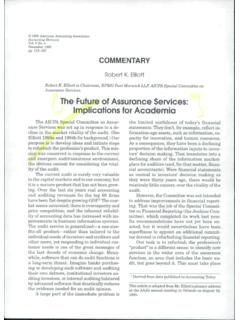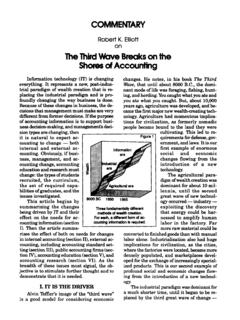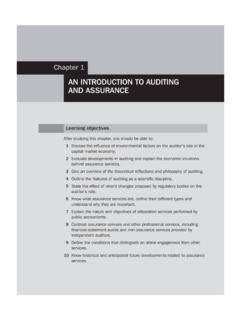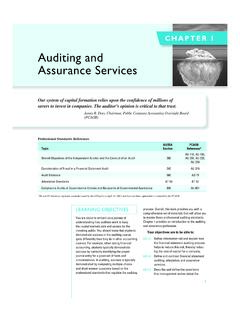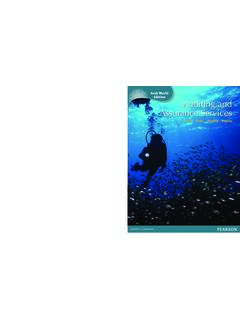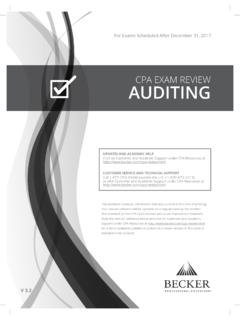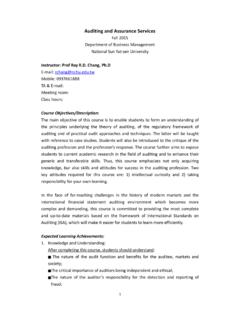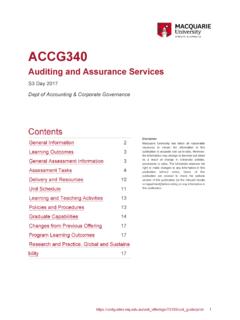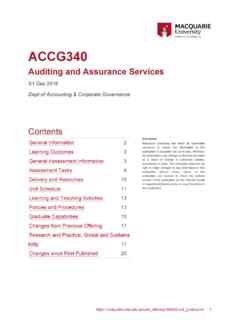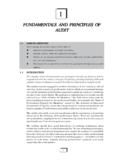Transcription of AICPA Special Committee on Assurance Services. …
1 1997 American Accounting AssociationAccounting HorizonsVol. 11 No. 4 December 1997pp. 61-74 COMMENTARYR obert K. ElliottRobert K. Elliott is Partner at KPMG Peat Marwick LLP and Former Chair of theAICPA Special Committee on Assurance Service Opportunities:Implications for AcademiaThe market for audits has been flat for anumber of years with no clear prospect of aturnaround. The AICPA 's Special Committeeon Assurance services (1997) publicized thatfact and responded by identifying new servicesand recommending processes for the ongoingidentification and development of additionalservices. The premise was always to build onthe audit tradition, and steady (though not ris-ing) demand for audits was projected into audit tradition is a professional assetof incalculable value.
2 It derives from the mar-ketplace need for high-quality, decision-mak-ing infonnation. The financial statement au-dit provides Assurance that an information setpresented to investors and creditors is the marketplace need for high quality in-formation is far greater than the need for reli-able historical-cost-basis financiai , Assurance services not only respondto the growth problems of the audit indus-try, they also adjust the audit tradition tothe wider marketplace it long ago was des-tined to serve, or so it seems in Special Committee on Assurance Ser-vices set in train three types of changes, asillustrated by figure 1. The smaller enclosedcube represents tbe profession's revenue fi-oinfinancial statement audits. The larger cubeextends three dimensions of the financial state-ment audit, which can be abbreviated as thewho, the what and the how of the service.
3 Thewho refers to the CPA's customers (who willexpand fi-om investors and creditors to includeentities' customers, employees, managers, di-rectors, and suppliers of goods and services ).Tbe what refers to the service provided (whichwill embrace Assurance on nonfinancial infor-mation and systems). The how refers to theservice-delivery technologies (which will in-clude real-time audit techniques, as well asevaluation of encryption, firewall strategiesand database design). services will include providing assuranceon nonfinancial information and on all sortsof information systems. The assurances maypertain to the relevance as well as the reli-ability of the information. Service-deliverytechnologies will address a broader range ofpotential defects in information and infor-mation systems, because information will beproduced and presented in different of evaluating manual detection andcorrection of errors, for example, assurerswill evaluate the design of systems for theirpreventive controls.
4 Real-time informationreports cannot wait for manual detection, sothe effectiveness of preventive controls willdetermine the reliability of the informationdecision makers CPA's customer base can (andshould) be all users of decision-making infor-mation. They include senior managers orother employees, members of corporate orThis article is adapted from Mr. Elliott's plenary ad-dress at the AAA's annual meeting in Dallas on August18, Horizons/December 1997 FIGURE 1 Strategic Expansion of "Audit Space"o 3-n -^InCustomersSuppliersEmployeesIndividua lsInvestorsCreditorsManual detectionand correction>f ^O/Technologybased preventionFinancial-statement auditAssurance on non-financialinformation and systemsnot-for-profit boards, institutional investors,analysts, individual investors and creditors,charitable donors and individuals who aremaking decisions about other matters, such asselecting personal medical care or arrangingcare for elderly family members.
5 All these par-ties are potential customers because they needdecision-making information and Assurance ofits decision-making information isunfortunately a universal experience foradults. They have encountered well-inten-tioned overstatements in social situations andmisleading information in commercial situa-tions. The ubiquitous jokes about advertisingcopy in our society are evidence that some wari-ness of misleading information is typical, andyou can go back to a centuries-long history ofconcern by decision makers that the informa-tion they receive is tainted by the interests ofthose who prepared it. People can take assur-ance from the credentials of the party supply-ing information and the circumstances underwhich it is supplied. One is more likely to be-lieve a scientist presenting a basic concept thana producer touting a film before it opens.
6 Whena decision is important, however, decision mak-ers are hkely to be most comfortable with as-surance from an independent party qualifiedto judge the quality of the way to put in perspective the range ofpotential new customers and Assurance servicesis to focus on an organization's external rela-tionships and the decision-making needs theypresent (although organizations also have agreat number of internal decisions to make,and organizations' decision makers are alsoimportant Assurance -service customers). Orga-nizations conduct transactions with: purchas-ers of their goods and services ; suppliers ofgoods, services and technologies; capital sup-pliers; and potential employees. Decisionsaboutthe transactions ( , sales of goods andservices, inventory purchases, exchanges ofsecurities for capital, and hiring) are supportedby two-way information fiows.
7 The arrows infigure 2 illustrate these fiows. In addition, theentity has accountability and regulatory rela-tionships as a member of its flows to and from communityagencies are necessary when decisionshave to be made about accountability andAssurance Service Opportunities: Implications for Academia63 FIGURE 2 Enterprise's External Information FlowsAdapted from C. K. Prahaladregulatory relationships ( , compliancewith regulations).CPAs have been most involved with arrow1 (the black arrow) through audits of financialstatements. Obviously, there are many otherinformation flows needed for entity decisionmaking, as the other arrows in the figure dem-onstrate. However, even the possibilities rep-resented by the black arrow are much greaterthan services needed to produce periodic finan-cial statements.
8 Today there are many otherinformation fiows to investors and 1 illustrates the range of informationfiows represented by the numbered arrows infigure makers using these informationfiows would benefit fi'om Assurance services ,and the prospect of such benefits would cre-ate economic demand for the services . IfCPAs do not meet the demand, others of the financial-statement audit,there is no statutory fi-anchise. Competitors'responses to the demand for additional as-surance services will have a great effect onthe CPA's practice environment. The oppor-tunities for CPAs will be enormous, but non-CPA competition will be an ever-presentcondition when attempting to take advan-tage of the OF ASSURANCESERVICESThe Special Committee 's definition of as-surance services attempted to capture thecentrality of decision makers' needs for qual-ity information and the full breadth of ser-vice possibilities that those needs open: Assurance services are independent profes-sional services that improve the quality of in-formation, or its context, for decision definition allows for expansion alongeach of the dimensions illustrated in figure 1 byserving new customers, providing new servicesand employing new technologies.
9 New assuranceservices have already been identified and AICPA processes put in place to identify and developadditional services in the future. The new ser-vices, both those in development and those thatwill be identified, have three implications foracademic accounting departments. The new ser-vices create training demands; they create new64 Accounting Horizons /December 1997 ArrowTABLE 1 Examples of External Information FlowsInformationFinancial statementsPress releasesAnalysts meetingsFact booksTruth in lending"Undertakings in offeringFinancial capacityProduct/service quality ( , ISO 9000)WarrantiesCredit termsProcurement specificationsFinancial condition (creditworthiness)Customer qualificationsCredentials/competenciesEm ployment historyReferencesBenefitsEmployment policiesCompensationJob-related informationTax policy/regulationsEmployment requirementsAir/water qualityEnvironmental restrictionsEnvironmental effects ( , ISO 14000)Employment effectsTax returnsresearch opportunities.
10 And they will helpredefine what we mean by accountancy as avocation, and, therefore, as an academic dis-cipline as well. Each of these implicationspresents the academic branch of the profes-sion with choices, some of them remainder of this article briefly ex-plores these three implications of assuranceservices. The exploration relies on the find-ings of the Special Committee on AssuranceServices. The Special Committee 's report, in-cluding its studies, background papers, anddescriptions of new services , are availableon-line at AND INCREASINGTHE VALUE OF THE AUDITThe Committee foresaw two types ofchanges in the audit that should affect whatis desirable education for , the evolution of information technol-ogy will have a number of influences onneeded audit capabilities.
